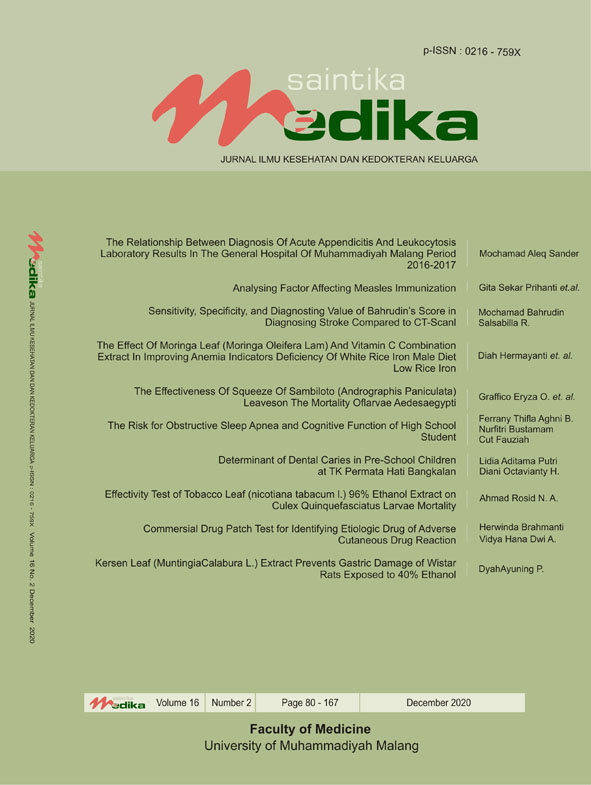The Effectiveness Of Squeeze Of Sambiloto (Andrographis Paniculata) Leaves On The Mortality Of Larvae Aedes Aegypti
DOI:
https://doi.org/10.22219/sm.Vol16.SMUMM2.11120Abstract
Dengue hemorrhagic fever has become a deadly disease since 2013. Dengue fever is a disease caused by dengue virus transmitted to humans through the bite of the Aedes aegypti. Eradication using chemical larvacides still has many disadvantages so that natural larvacides from plants are needed, one of which is larvacide from the squeeze of the sambiloto (Andrographis paniculata) leaves. The squeeze of the sambiloto leaf (Andrographis paniculata) contains flavonoids, alkaloids, tannins and saponins which have natural larvacidal activity. This research aims to determine the killing power of the squeeze of sambiloto (Andrographis paniculata) leaves against Aedes aegypti larvae and determine the most effective concentration as larvicide. This research was experimental laboratory with post test only controlled group design method. There are 600 instar III Aedes aegypti Larvae randomly divided into 6 groups (5%, 10%, 15%, 20%, aquadest and abate). Using 4 repetitions each group was observed every 6 hours for 24 hours. Based on the results of the Kruskal-Wallis non-parametric statistical test obtained p-value = 0,001 which means there are significant differences in larvicidal effects between groups. The concentration of 15% and 20% are the most effective in killing the larvae of Aedes aegypti.
Downloads
References
Ama Afrindayanti, 2017. Efektifitas Buah Belimbing Wuluh (Averrhoa bilimbi L.) Sebagai Larvasida Nyamuk Aedes sp. (Skripsi). Kendari: Polotehnik Kesehatan Kendari Kementerian Kesehatan Republik Indonesia.lia, R. 2016. Daya Bunuh Air Perasan Daun Mengkudu (Morinda Citrifolia) Terhadap Kematian Larva Aedes aegypti. Universitas Negeri Semarang: Semarang. Dinas Kesehatan Kabupaten Sukoharjo, 2015. Profil Kesehatan Kabupaten Sukoharjo. Sukoharjo: Depkes. Dinas Kesehatan Provinsi Jawa Tengah, 2018. Profil Kesehatan Provinsi Jawa Tengah Tahun 2017. Semarang: Dinkes Jateng. Duangkaew, P., Phouyfung, P., Jirakanjanakit, N., & Rongnoparut, P. (2018). Combined larvicidal efficacy of rhinacanthin-c, luteolin, quercetin, and binary mixtures of rhinacanthus nasutus, andrographis paniculata and vernonia cinerea extracts against aedes aegypti mosquito. International Journal of Agricultural Technology. Edwin, E. S., Vasantha-Srinivasan, P., Senthil-Nathan, S., Thanigaivel, A., Ponsankar, A., Pradeepa, V., … Al-Dhabi, N. A. (2016). Anti-dengue efficacy of bioactive andrographolide from Andrographis paniculata (Lamiales: Acanthaceae) against the primary dengue vector Aedes aegypti (Diptera: Culicidae). Acta Tropica. https://doi.org/10.1016/j.actatropica.2016.07.009 Fathia, A., Argadireja, D. & Ismawati, 2019. Larvacidal Effect of Ethanol Extract of Sambiloto Leaves (Andrographis Paniculata) on The Death of Aedes Aegypti Larvae in Vitro. Prosiding Pendidikan Dokter, Volume 5. Istiana, I. & Heriyani, F., 2012. Resistance status of Aedes aegypti larvae to temephos in West Banjarmasin. Jurnal Buski, Volume 4. KEMENKES, 2018. DEPKES Info Datin Situasi Demam berdarah Dengue. [Online] Available at: http://www.depkes.go.id/download.php?file=download/pusdatin/infodatin/InfoDatin-Situasi-Demam-Berdarah-Dengue.pdf [Accessed 26 Mei 2019]. Mau, F., Ira, & Bule, S. (2014). Dengue Hemorrhagic Fever And TransOvarial Transmission Of Dengue Virus In Aedes Spp. Jurnal Penyakit Bersumber Binatang, 1-7. Minarni, E., Armansyah, T., Hanafiah, A. 2013. Daya Larvasida Perasan Etil Asetat Daun Kemuning (Murraya paniculata (L) Jack) Terhadap Larva Nyamuk Aedes aegypti, Jurnal Medical Veterinaria, vol.7, no.1, hlm. 27–29. Sukkanon, C., Karpkird, T., Saeung, M., Leepasert, T., Panthawong, A., Suwonkerd, W., … Chareonviriyaphap, T. (2019). Excito-repellency Activity of Andrographis paniculata (Lamiales: Acanthaceae) Against Colonized Mosquitoes. Journal of Medical Entomology. https://doi.org/10.1093/jme/tjz139 Tennyson, S., Samraj, D. A., Jeyasundar, D., Chalieu, K., College, M. C., & Nadu, T. 2013. Larvicidal Efficacy of Plant Oils Against the Dengue Vector Aedes aegypti ( L .) ( Diptera : Culicidae ). Middle-East Journal of Scientific Research, 13(1), 64- 68 WHO, 2005. Guiedlines For Laboratory and Field Testing Of. [Online] Available at: http://apps.who.int/iris/bitstream/handle/10665/69101/WHO_CDS_WHOPES_GCDPP_2005.13.pdf [Accessed 29 Agustus 2018]. Yunita, E. A., Suprapti, N. H. & Hidayat, J. W., 2009. Pengaruh Ekstrak daun Teklan (eupatorium riparium) terhadap Mortalitas dan Perkembangan Larva Aedes aegypti. BIOMA, Juni, 11(1410-8801), pp. 1
Downloads
Published
Issue
Section
License
Authors who publish with this journal agree to the following terms:
- Authors retain copyright and grant the journal right of first publication with the work simultaneously licensed under a Creative Commons Attribution-ShareAlike 4.0 International License that allows others to share the work with an acknowledgment of the work's authorship and initial publication in this journal.
- Authors are able to enter into separate, additional contractual arrangements for the non-exclusive distribution of the journal's published version of the work (e.g., post it to an institutional repository or publish it in a book), with an acknowledgment of its initial publication in this journal.
- Authors are permitted and encouraged to post their work online (e.g., in institutional repositories or on their website) prior to and during the submission process, as it can lead to productive exchanges, as well as earlier and greater citation of published work (See The Effect of Open Access).

This work is licensed under a Creative Commons Attribution-ShareAlike 4.0 International License.
















